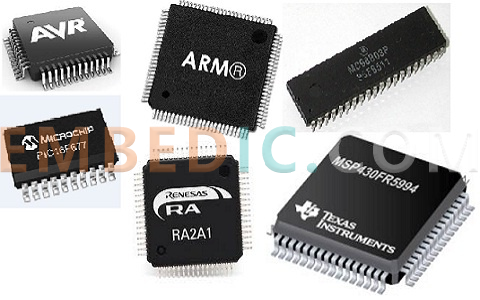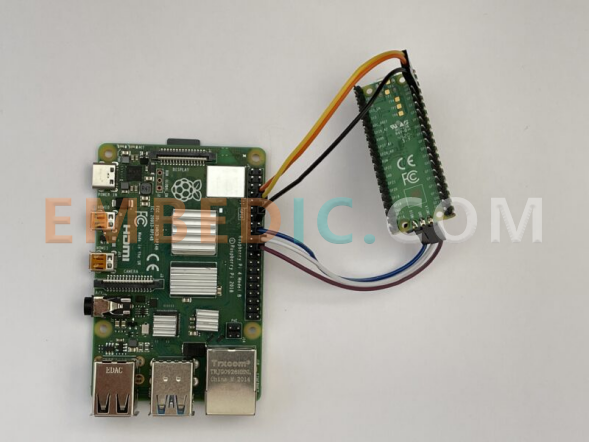There are several commonly used microcontrollers:

1. 8051 series: The 8051 series is one of the earliest and most common 8-bit microcontrollers widely used in many applications. It has a rich set of peripherals and a wide development ecosystem.
2. AVR Series: The AVR series of microcontrollers is a family of 8-bit and 32-bit microcontrollers manufactured by Atmel. It has low power consumption, high performance and rich peripherals and is widely used in embedded systems and IoT devices.
3. PIC Series: The PIC series is a family of microcontrollers produced by Microchip Technology. It has low cost, low power consumption and rich peripherals, and is widely used in consumer electronics, industrial control and automation.
4. ARM Cortex-M series: ARM Cortex-M series is a 32-bit processor architecture that is widely used. Among them, Cortex-M0/M0+ is suitable for low-power and cost-sensitive applications, Cortex-M3/M4 is suitable for higher performance real-time control applications, and Cortex-M7 is suitable for high-performance embedded systems.
5. STM32 series: The STM32 series is a family of microcontrollers based on the ARM Cortex-M core produced by STMicroelectronics. It has rich peripherals and powerful performance, and is widely used in industrial control, Internet of Things, automotive electronics and other fields.
6. ESP8266/ESP32: ESP8266 and ESP32 are low-cost, low-power Wi-Fi modules produced by Loxin Technology with integrated microcontrollers that can be used as microcontrollers. They are widely used in IoT, smart home and other fields.
These are just some commonly used microcontroller series, there are other microcontroller series, such as Freescale Kinetis series, TI MSP430 series, etc. Different microcontrollers have different characteristics and applications, you can choose the right microcontroller according to the specific project requirements and application scenarios.
When debugging the microcontroller program, there are several types of common problems:

1. Hardware problems: The process of MCU program debugging may involve hardware problems, such as the power supply is not properly connected or the external components are damaged, etc. These problems will cause the program not to run normally.
2. Code Problems: In the process of program debugging, there may be code problems, such as logic errors, dead loops, insufficient system resources, etc. These code problems will lead to the program can not run normally or the results are different from the expected value.
3. debugging tool problems: microcontroller program debugging process may involve debugging tool configuration problems, debugging tool software problems, etc., these problems will affect the normal use of debugging tools and the reliability of debugging results.
4. Misoperation during debugging: In the process of MCU debugging, there may be human misoperation, such as wrongly setting breakpoints, mistakenly deleting code, mistakenly adjusting registers, etc. These misoperations will affect the debugging of the program and the analysis of the results.
For the above problems, the following measures can be taken:
With the STM32 series being a cornerstone of microcontroller technology, understanding the nuances of debugging these powerful devices in the current year of 2023 is essential.
STM32 microcontroller generally has the following debugging modes:
1. SWD (Serial Wire Debug) debug mode:
SWD is one of the commonly used debugging modes for STM32 microcontrollers. It performs debugging and programming operations through a single debug pin (SWDIO) and clock pin (SWCLK). Using SWD debugging mode, you can perform single-step debugging, breakpoint debugging, checking the status of registers and other operations.
 debug mode.png)
2. JTAG (Joint Test Action Group) debugging mode:
JTAG is also a common debugging mode, which can be used for hardware debugging and programming.JTAG debugging mode uses multiple pins, including TMS, TCK, TDI, TDO, etc., which can realize more comprehensive debugging and programming functions.
 debugging mode.png)
3. SWO (Serial Wire Output) debug mode:
SWO debug mode is a passive debug mode for outputting debug information. Through the SWO pin, debugging information can be output to the debugger or development environment at runtime, which is convenient for debugging and analyzing the code.
 debug mode.png)
4. Bootloader mode:
In addition to the debug mode, the STM32 microcontroller can also be debugged and programmed through the Bootloader mode. In Bootloader mode, firmware update, burning and debugging operations can be performed through the serial port or USB interface.
Manufacturer: Texas Instruments
IC DGTL MEDIA PROCESSOR 529FCBGA
Product Categories: DSP
Lifecycle:
RoHS:
Manufacturer: Microchip
IC MCU 8BIT 16KB FLASH 28SSOP
Product Categories: 8bit MCU
Lifecycle:
RoHS:
Manufacturer: Texas Instruments
IC DGTL MEDIA PROCESSR 1031FCBGA
Product Categories: DSP
Lifecycle:
RoHS:
Manufacturer: Texas Instruments
IC DSP FIXED-POINT 529FCBGA
Product Categories: DSP
Lifecycle:
RoHS:
Looking forward to your comment
Comment